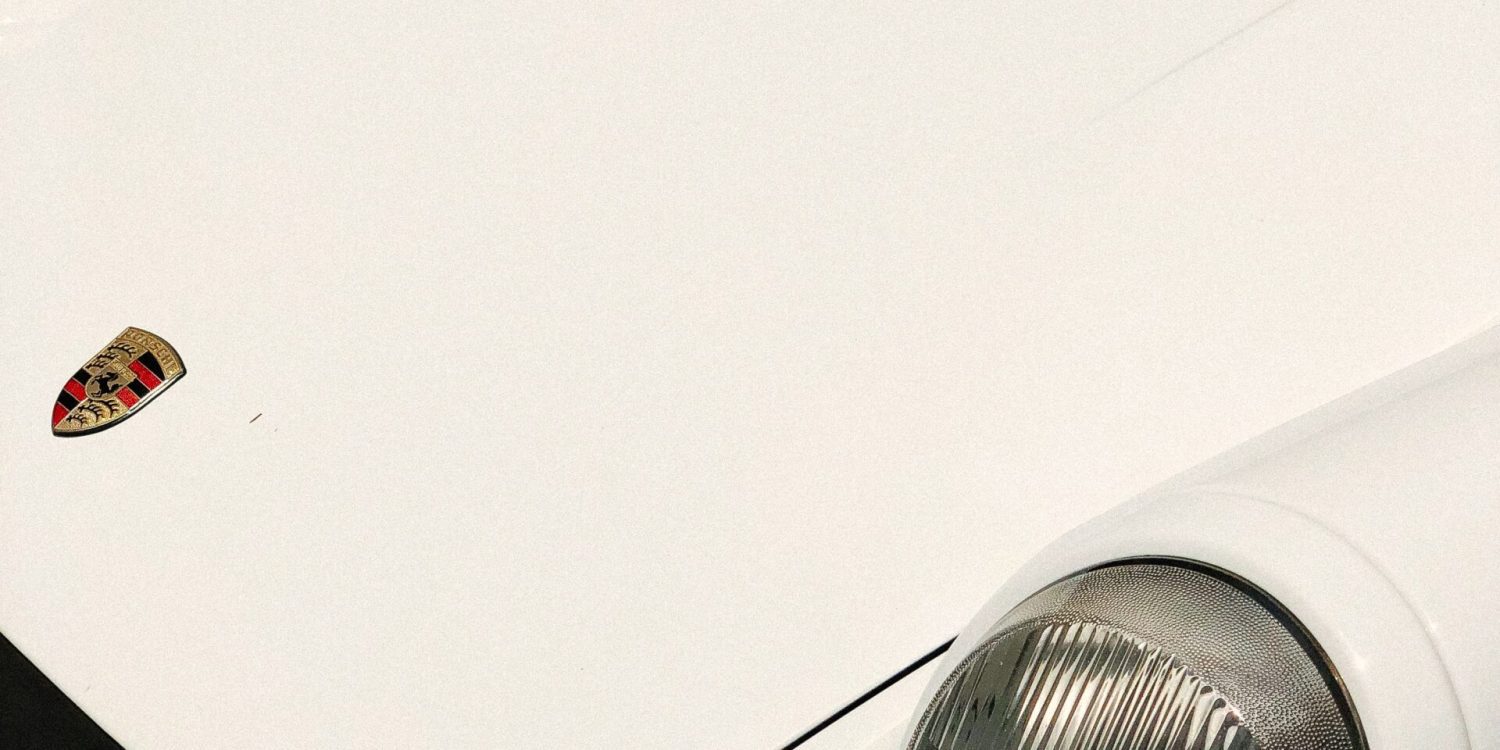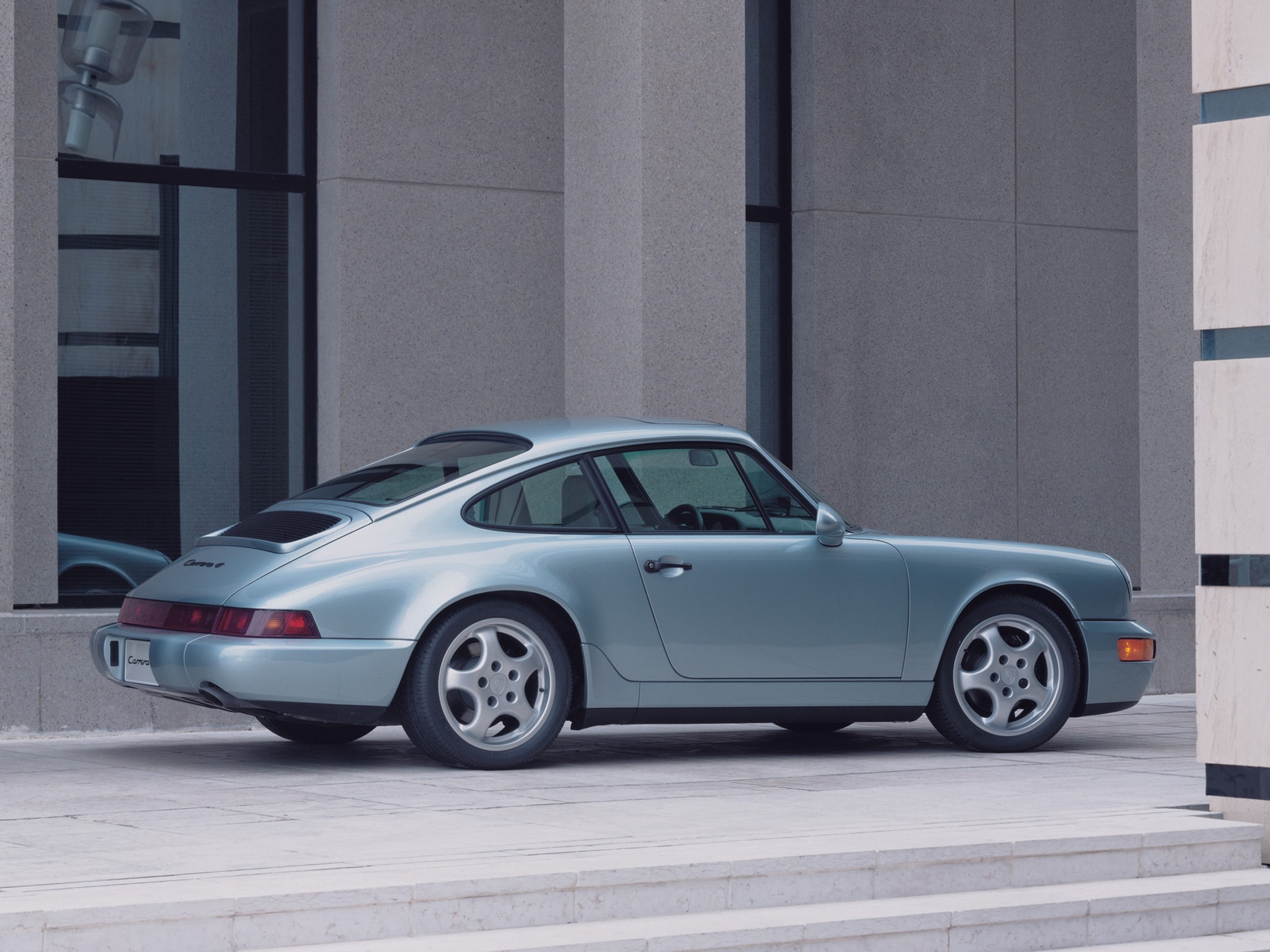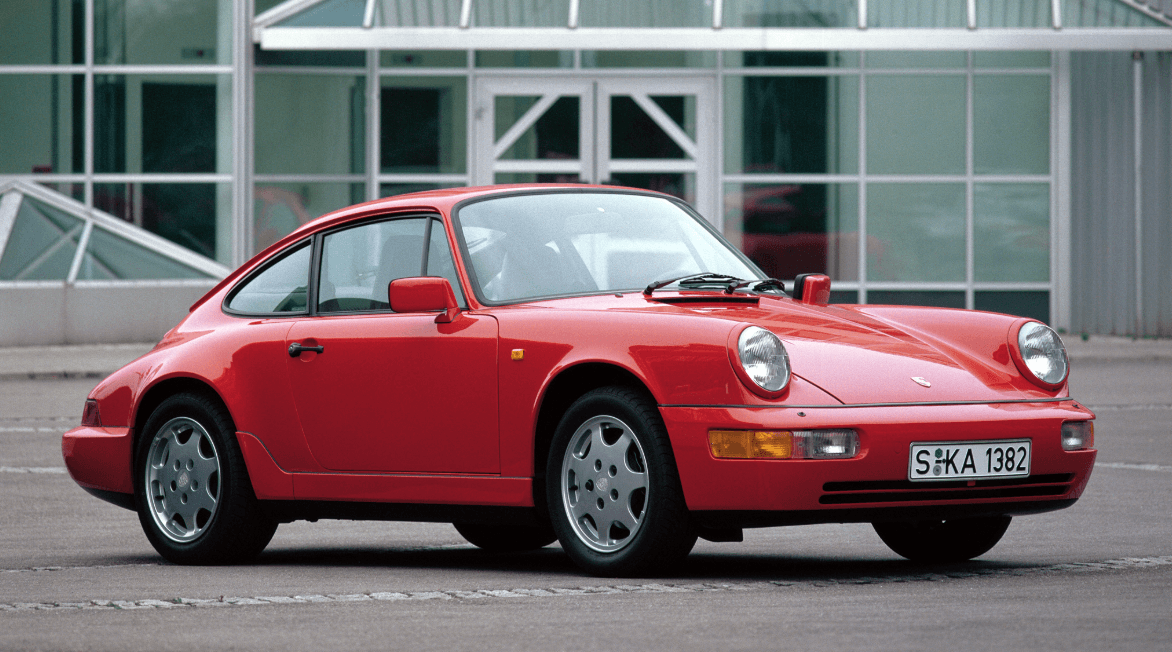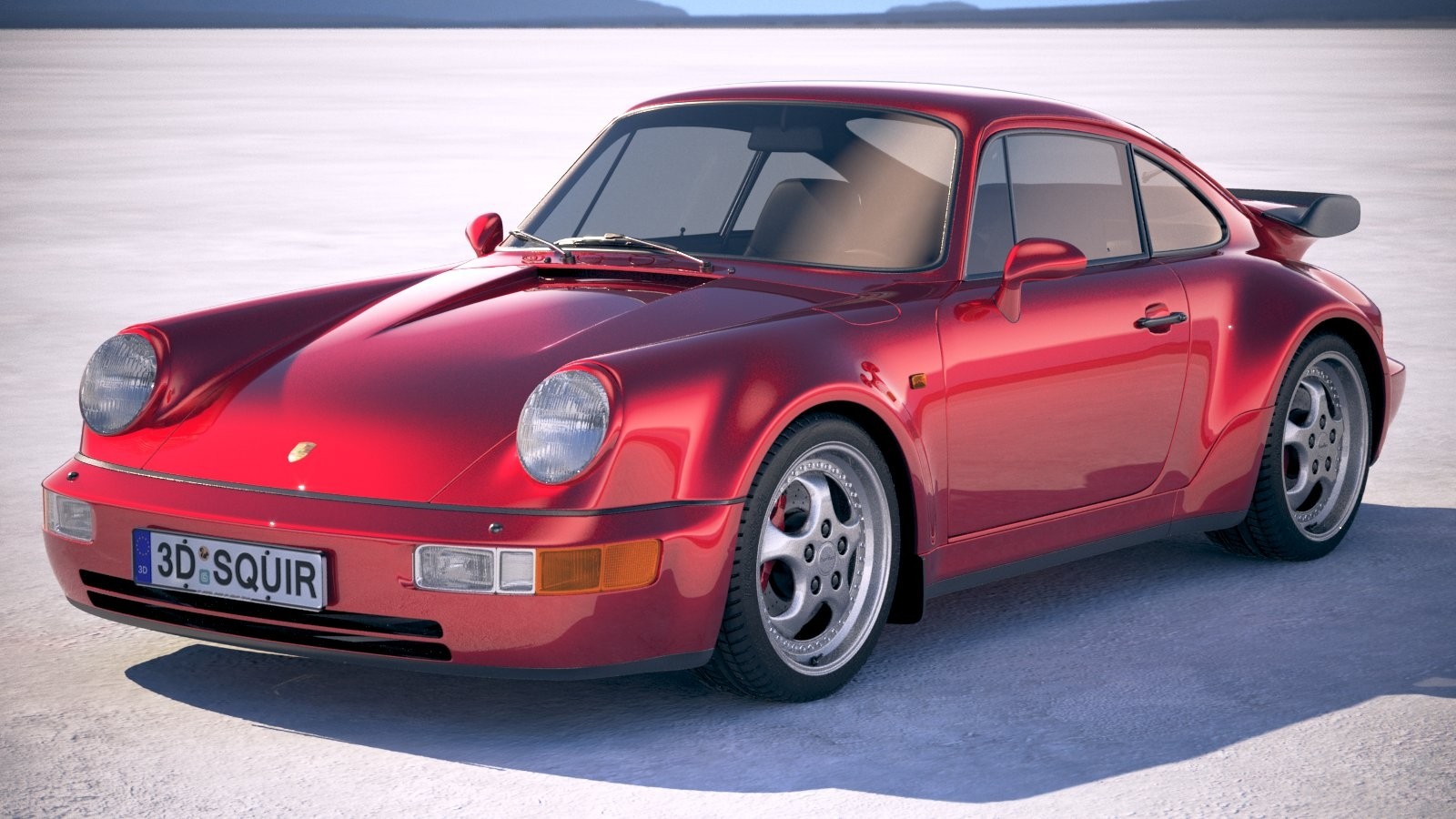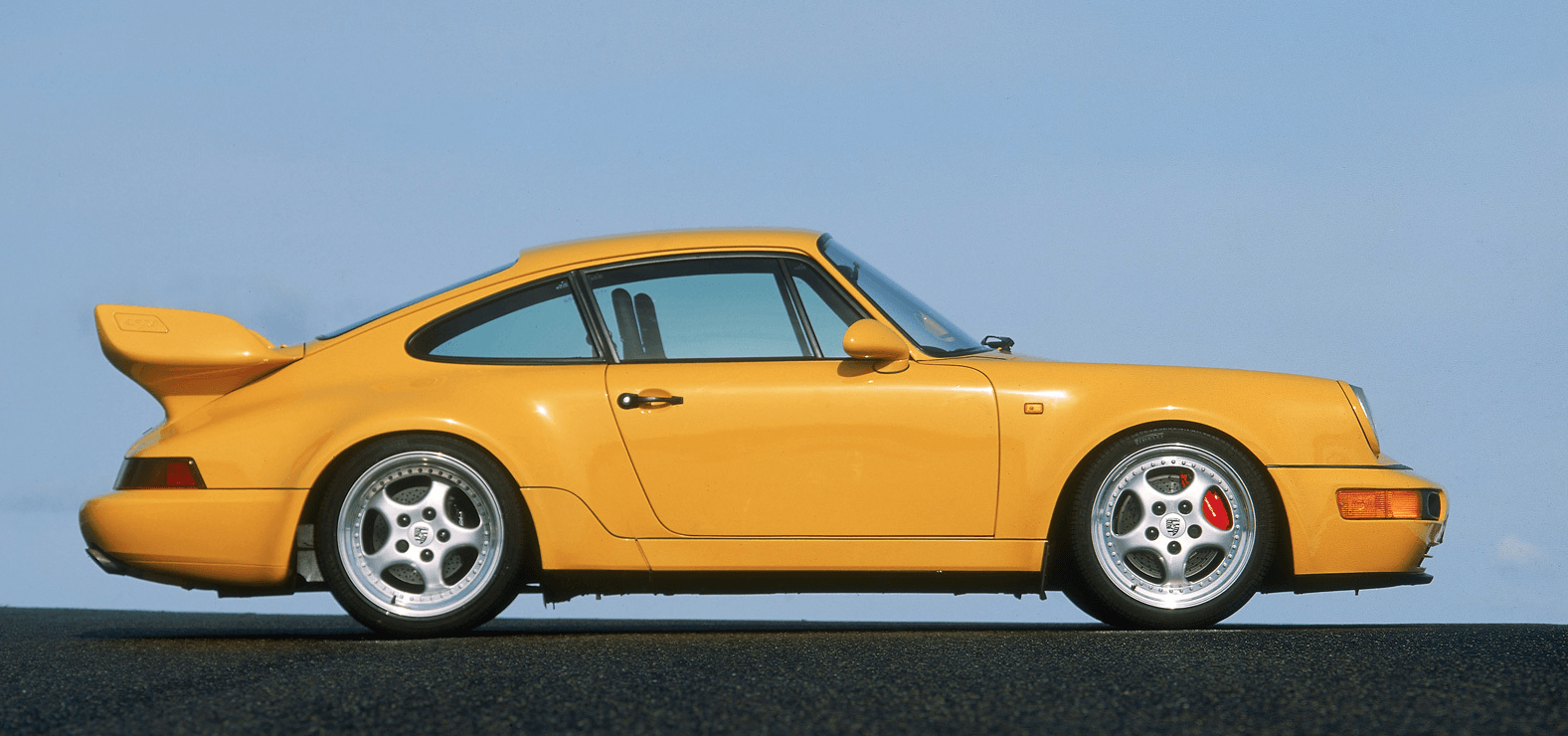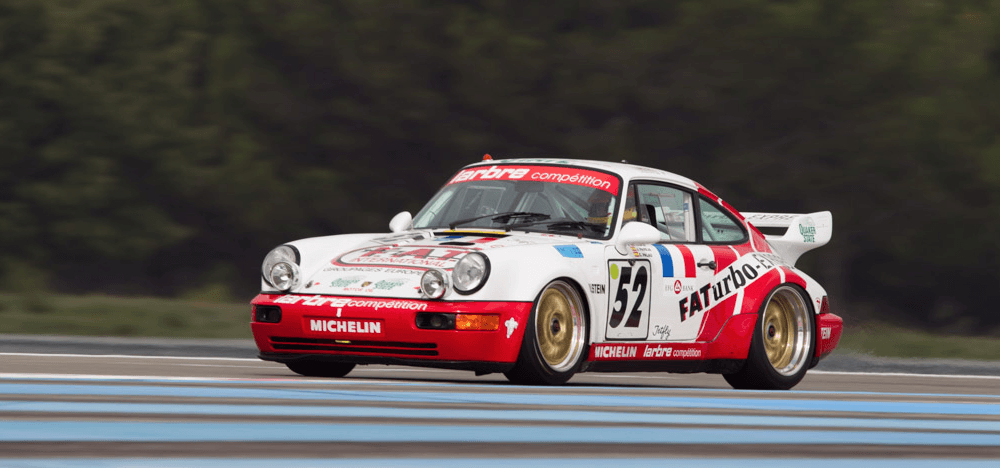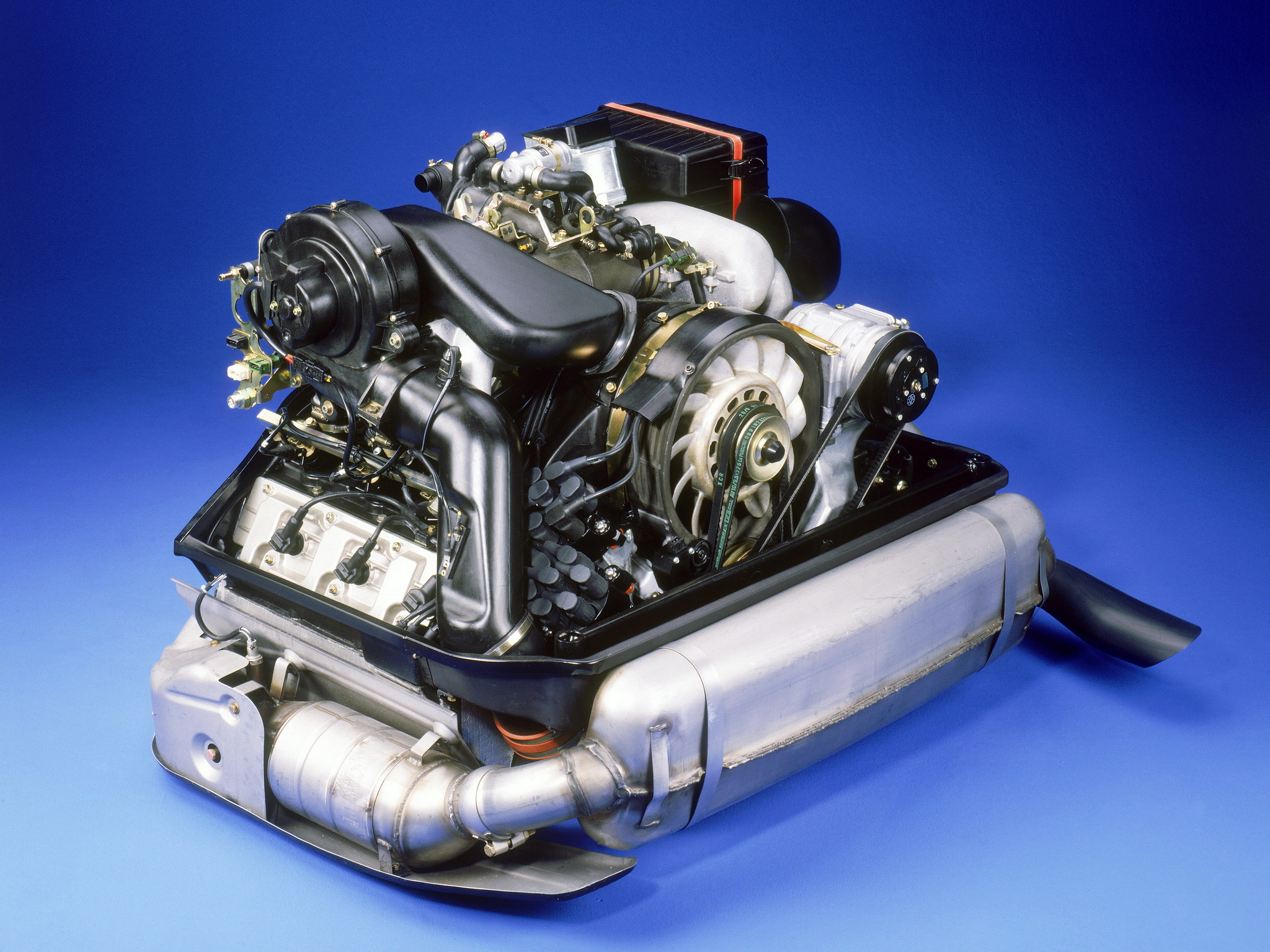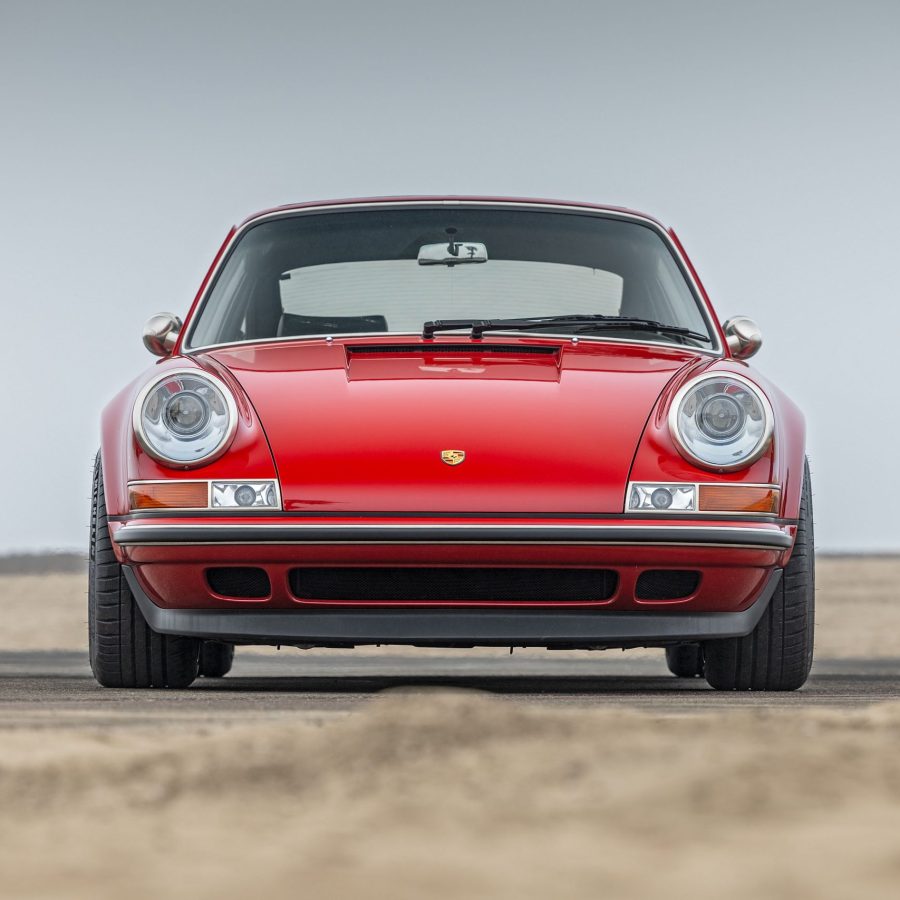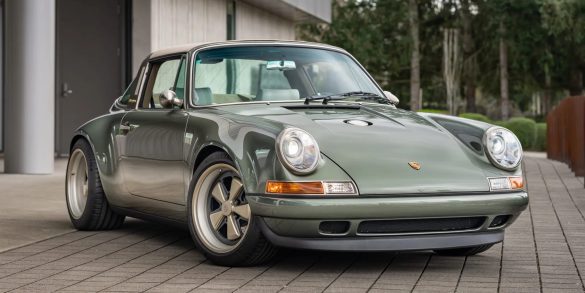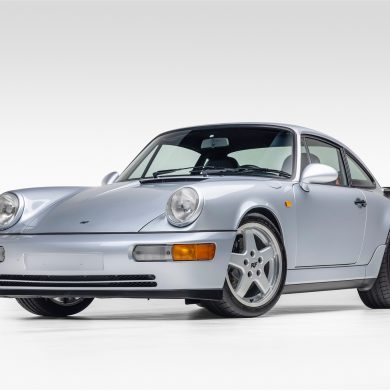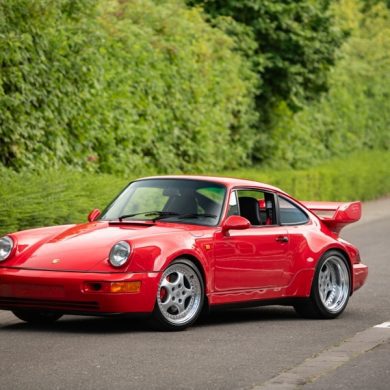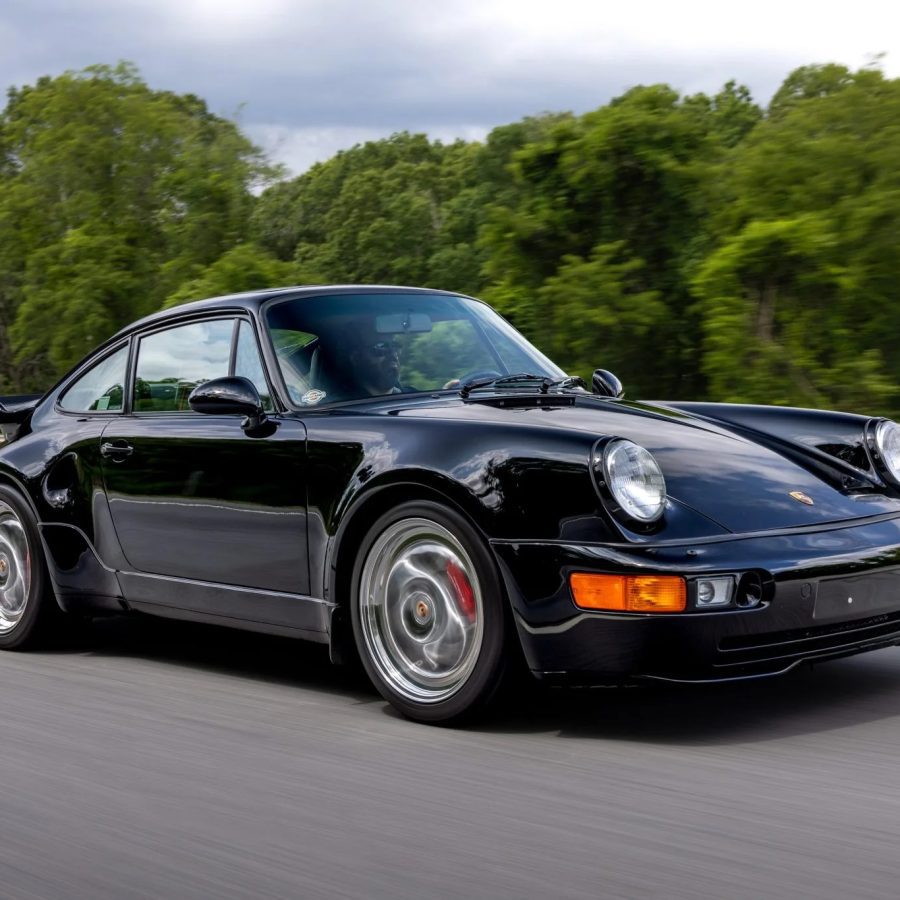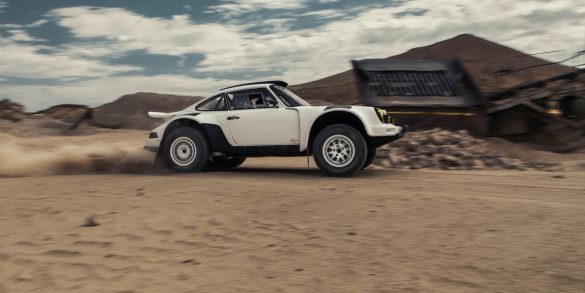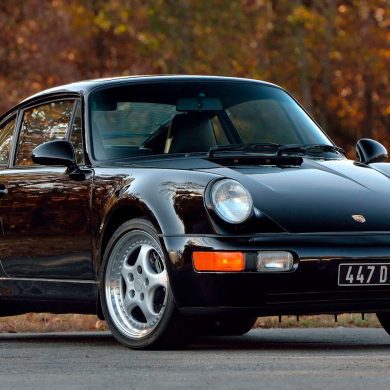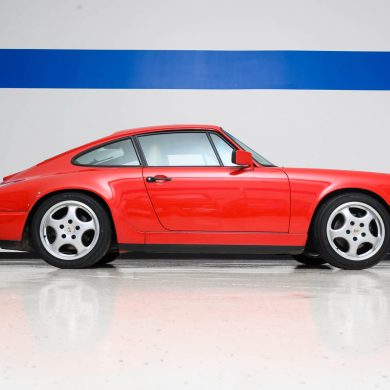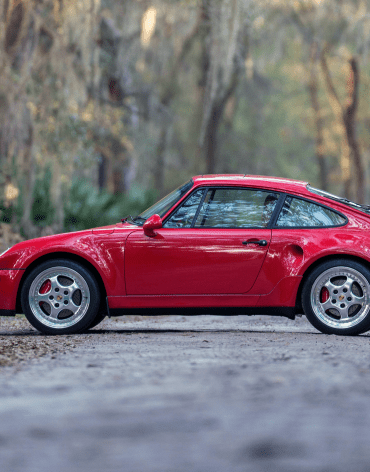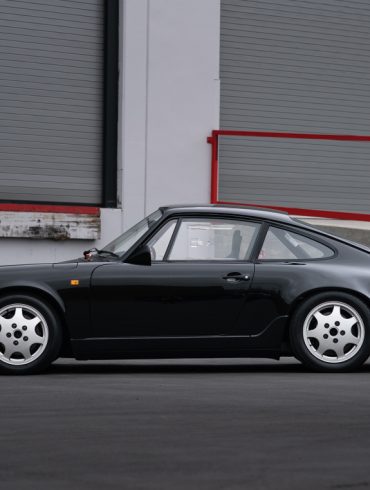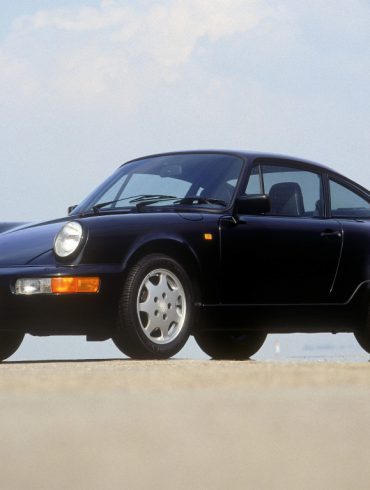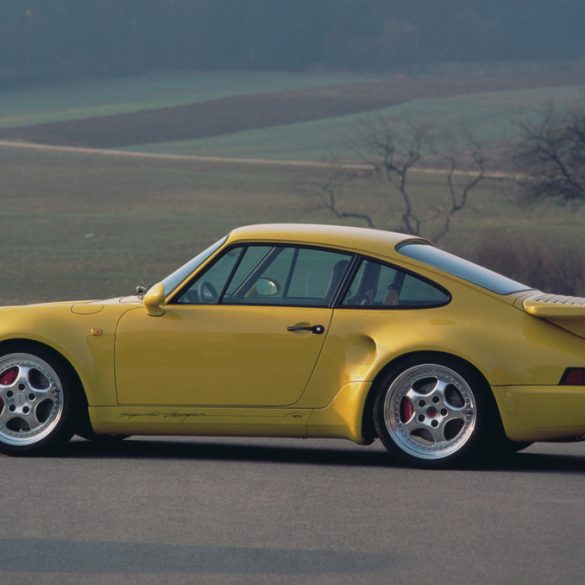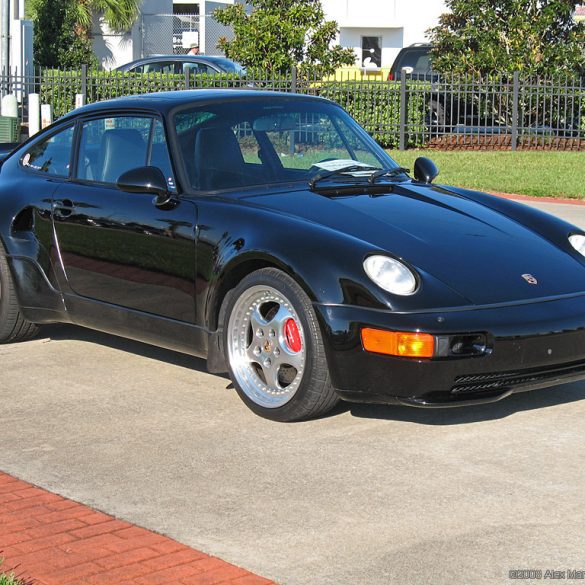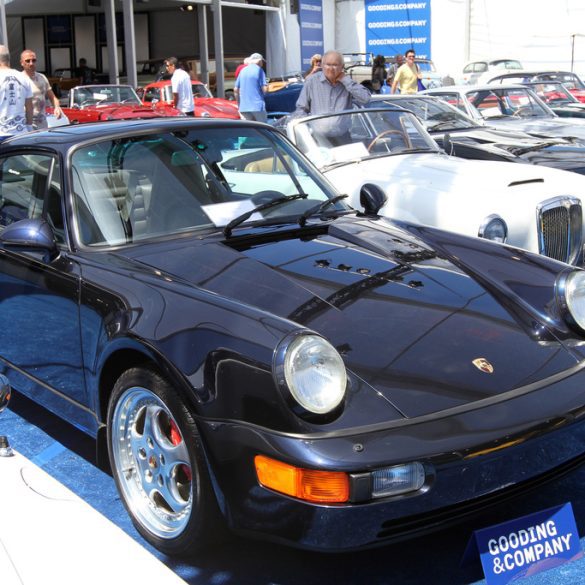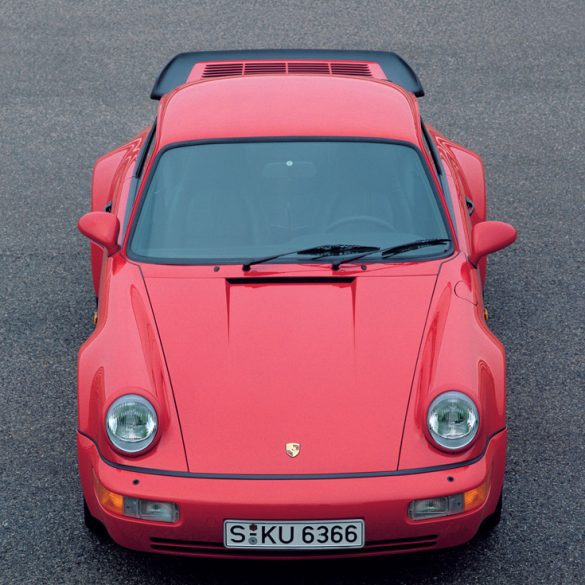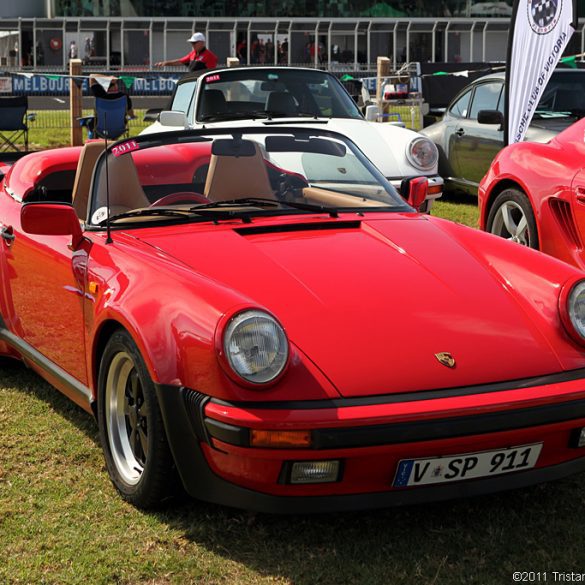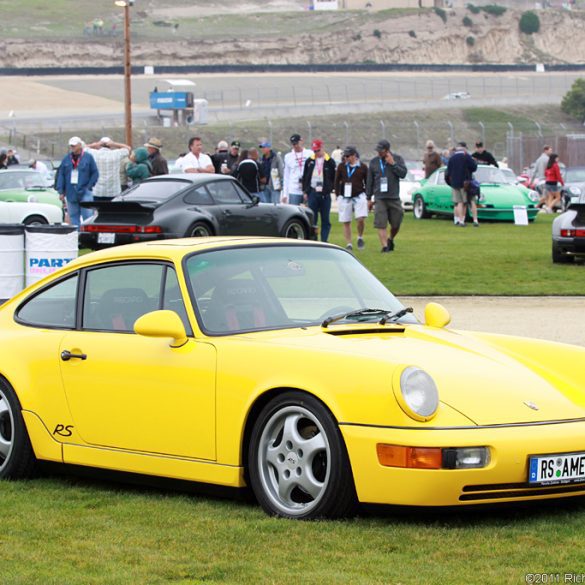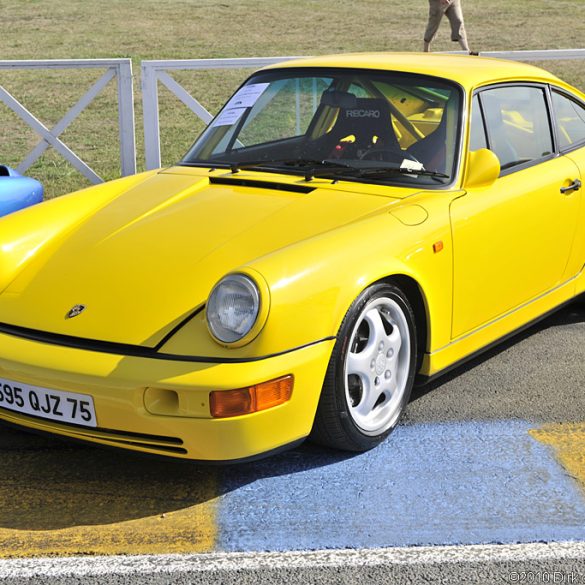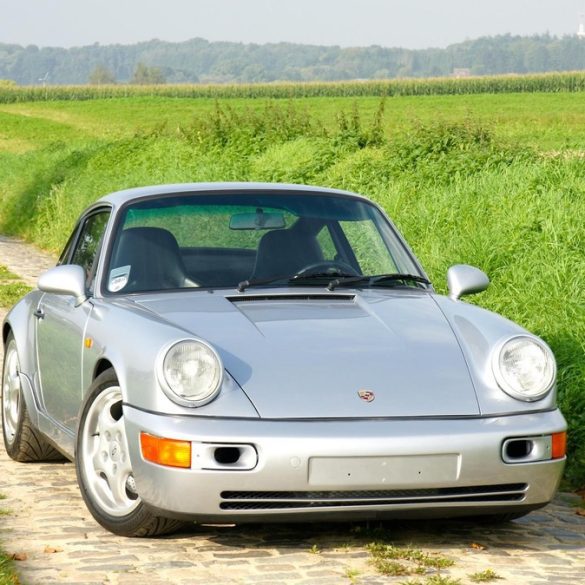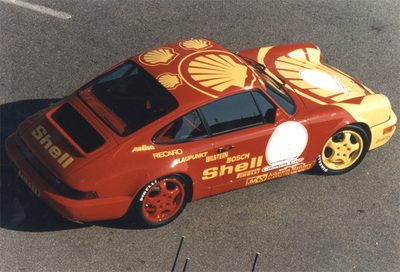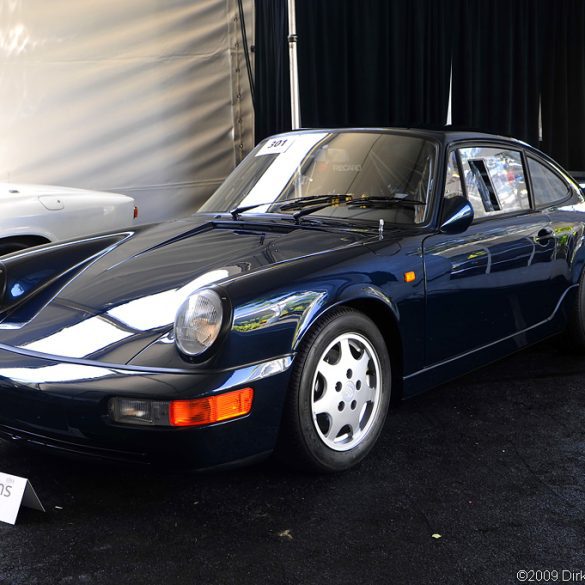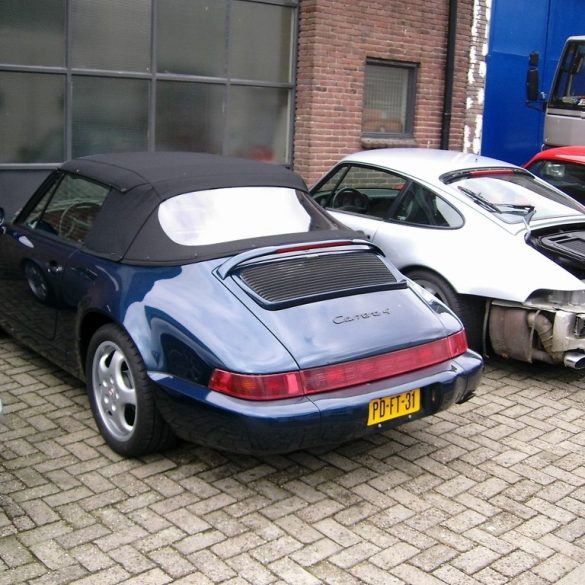Porsche 911 (964)
The Ultimate Guide to the 1989 - 1994 Porsche 911
The Porsche 964: a bridge between classic and modern, this often-overlooked 911 generation (1989-1994) marked a turning point for the iconic sports car. 1 This is your ultimate guide to the 964, exploring its revolutionary features, distinctive variants, and enduring legacy. From the groundbreaking Carrera 4 to the rare and coveted Turbo S Leichtbau, we delve deep into the 964's history, performance, and why it deserves a place among the greatest 911s ever built.
Carerra 4 / Carrera 2 / Turbo / RS / Race / Engines / VIN / Sales / Specs / Buyer Guide / The Market / Deep Dives
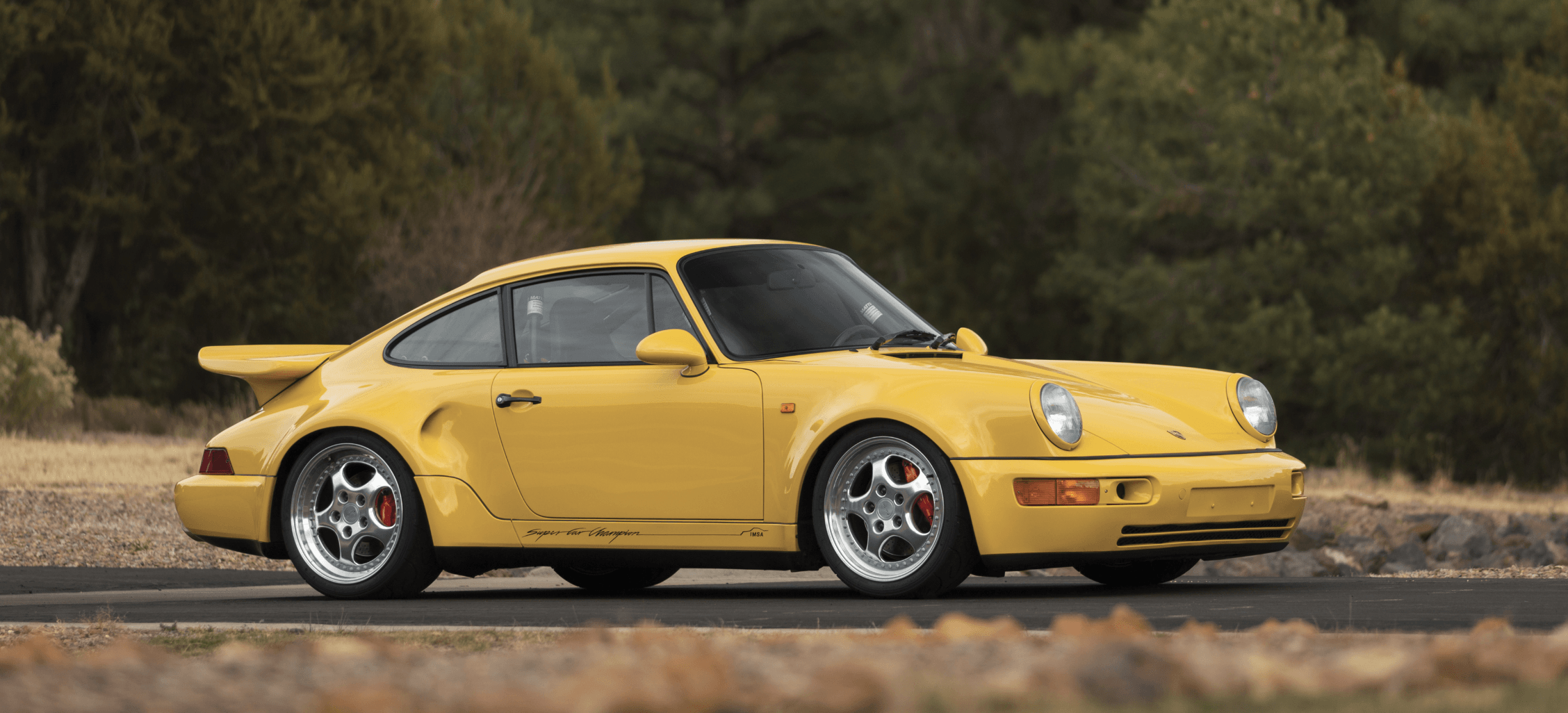
The Ultimate Guide To The Porsche 964: Every Variant, Specs, Reviews, Performance & More
In 1989 Porsche came out with the 911 Carrera 4 (964). The new 911 was a contemporary take on the classic two-door sports car and came at a time when many were predicting the end of the 911 (the company was producing the 944 and working on the upcoming 968). The long run of the previous 911 meant the 964 needed a major update and Porsche delivered on that promise with 85% new components and virtually none of the predecessor’s architecture used.
Save for the introduction of aerodynamic polyurethane bumpers and an automatically-extending rear spoiler which replaced the “whale tail” found on the 911 throughout the 1980’s, externally, the 964 kept the same style as the classic 911. The interior was an almost entirely reimagined Porsche 911 with more modern design that was intended to blend performance with comfort. The new 911 featured many creature comforts that had been lacking in earlier versions of the car including a Tiptronic automatic transmission, power steering, dual front airbags, dual-mass flywheel, ABS, retractable rear spoiler and twin-spark ignition.
The 964 rode on a completely redesigned chassis with rear suspension switching from torsion bar to trailing arms with Porsche’s “Weissach” rear axle, which added self-steering elements to reduce the chance of oversteer. It featured a naturally aspirated 3.6 liter boxer engine that produced an impressive 250 horsepower. It was the introduction of an all-wheel drive Carrera 4 model that really captured the attention of the automotive community as a whole. The fully mechanical all-wheel drive system was revolutionary for its time, sensing wheels slippage and automatically transferring power elsewhere, ensuring that the driver could maintain a greater degree of control whenever the driving environment became less manageable.
The 964 generation was a revelation. It modernized the 911 without losing its essential character. The ride was more comfortable, the handling more predictable, and the performance was simply breathtaking...
Stuttcars.com
Porsche 911 (964) Basics
Manufacturer: Porsche
Also called: Porsche 964, Type 64
Type: 964
911 Generation: Third Generation
Production Years: 1989 - 1993
Model Years: 1989 - 1994
Designer: Benjamin Dimson
Body Style: 2 Door Coupe, 2-Door Roadster, 2-Door Targa
Layout: Rear-engine, RWD/AWD
Engines: 3.3 L M30/69 turbo flat-6, 3.6 L M64/01, 02, 03, 3.6 L M64/50 turbo, 3.75 L M64/04 (3.8 RS/RSR)
Trans: 4-speed auto, 5-speed manual
Production: 63,762 units
Premiere: 1988 September 28 at Mondial de l'Automobile Paris show
Predecessor: Porsche 911 G-Series
Successor: Porsche 911 993
Did You Know?
Before the 964, every 911 had been rear-wheel drive. The 964 Carrera 4, launched in 1989, introduced all-wheel drive to the 911.
The 964 was the first 911 to feature an automatically extending rear spoiler. This innovative design element improved aerodynamics at higher speeds while maintaining a clean profile when not needed.
The 964 was among the first cars to offer Porsche's Tiptronic transmission.
The 964 is actually the rarest generation of the 911! Porsche produced just over 63,000 examples, compared to over 196,000 of the preceding G-series.
Lots More
If you want more 964, check out our sister website Stuttcars.com for the ultimate guide to the Porsche 911 (964).
Variants Galore
After the 964 Carrera 4 was introduced, effectively solving many of the oversteer tendencies of the previous generation, a rear-wheel drive Carrera 2 was added 6 months later. The Carrera 2 was actually the rear-wheel drive version of the car which packed almost the same technical specifications as the base model. The engine was the same 3.6 liter unit which produced 250 horsepower and a maximum speed of 260 km/h while the 0 to 100 km/h acceleration was made in 5.7 seconds.
In addition to the base model Carrera Coupe, Cabriolet and Targa versions, the 1990 Porsche 911 offerings also included a Type 964 Turbo option. When first introduced in March, 1990, the 911 Turbo initially featured a turbocharged 3.3 liter boxer engine that was carried over (with updates) from the previous 911 Turbo model, albeit with reduced turbo lag. In 1992, the Porsche 911 Turbo was upgraded to a more powerful 3.6 liter power plant delivering 320 horsepower. At the end of 964 production in 1994, the Porsche factory had some 90 Turbo chassis left and gave them the Porsche Exclusive treatment to create a very special Turbo 3.6 S model with 380 horsepower.
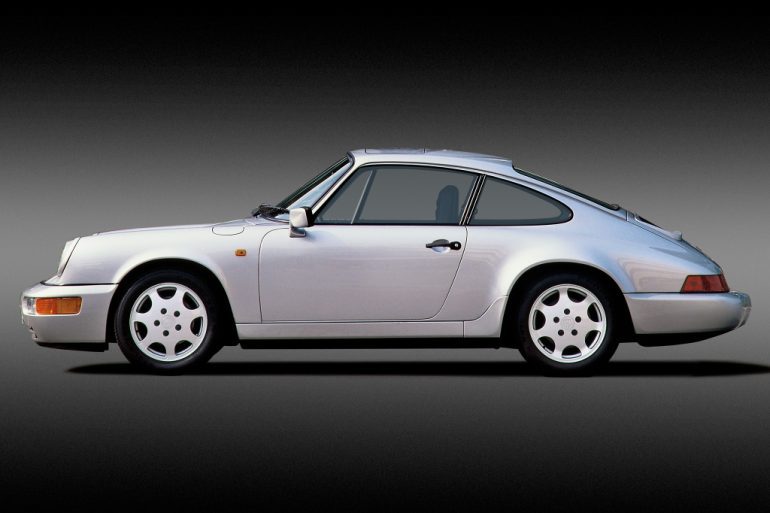
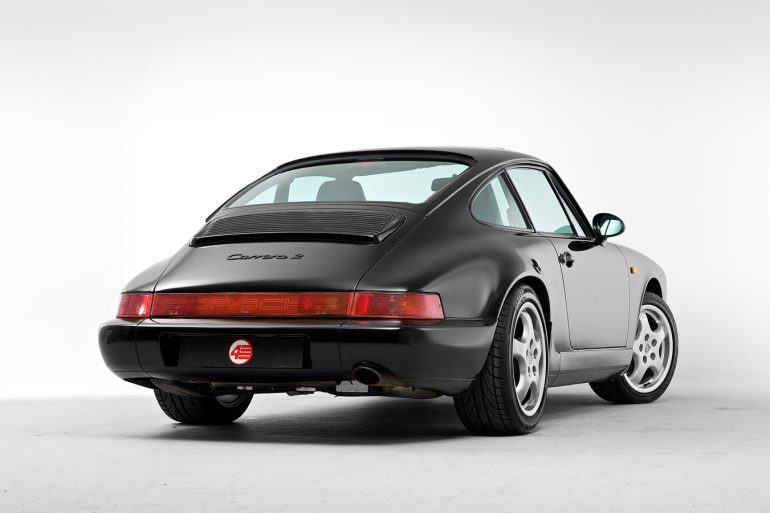
Special Edition Heaven
Several other special edition 964s were made and they are some of the most sought after cars in the classic car market today. In 1992 there was the America Roadster which was essentially a turbo-bodied cabriolet. It had the standard electric spoiler and turbo guards and mechanically was the same as the standard model apart from 17″ cup wheels and the brakes and suspension. Only 250 of this variant were produced.
There was also the Porsche 964 Speedster which came in two distinct incarnations. The first was the 1989 model year Speedster which was basically a 930 turbo under the covers. The “true” 964 Speedster was the 1994 Speedster which was based on the 964 Carrera 2 platform. More than three quarters (641) of the 800 built had the “Turbo look” wide-body option. Porsche planned to build 3000 examples of the 1994 Speedsters in 1992, but only 936 examples were built and sold.
Super Lightweight
In 1992, Porsche produced a super-lightweight, rear-wheel-drive only version of the 964 dubbed Carrera RS for the European market using their “Carrera Cup” race car as a base. It featured a revised version of the standard engine with 260 bhp and lightweight flywheel coupled an upgraded gearbox with closer ratios, asymmetrical Limited Slip Differential and steel syncromesh. A revised (track focused) suspension, no power steering and stiffer springs, shocks and adjustable stabilizer bars made it a real performer. It went a diet too with the interior totally stripped out and all creature comforts removed. Lightweight wheels, body parts and thinner windows also helped the Carrera RS weigh 345 pounds less than a Carrera 2.
There was also a heavier Touring variant (with sound deadening, power seats (optional), undercarriage protection and power windows) and an N/GT racing variant with a stripped, blank metal interior and a roll cage. A later ultra-limited production version, the Carrera 3.8 RS featured the Turbo body and a 300 bhp, bored out 3.8 liter motor was sold briefly in Europe. The Carrera RS was not sold in the United States.
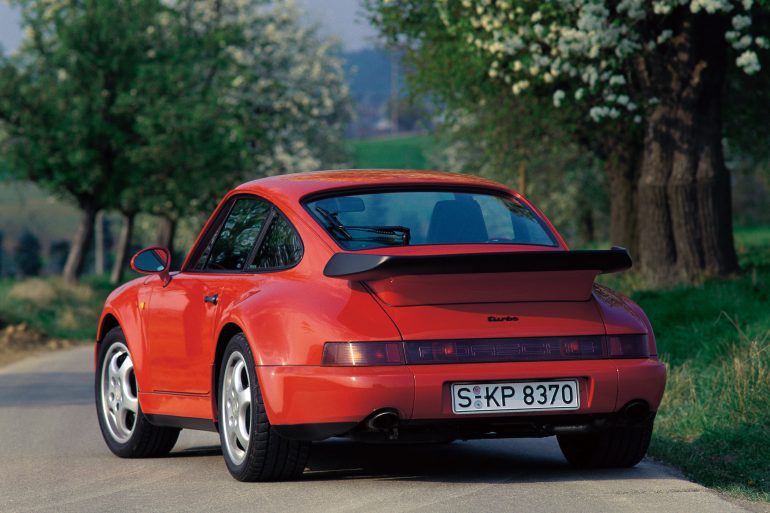
Porsche 964 Carrera 4
Model Years: 1989-1994 / Engine: 3.6 L Aircooled Flat 6 (M64/01) / Production: 20,395 / Body Styles: Coupe, Cabriolet, Targa
The Type 964 911 first launch with an all wheel drive model. It was a serious investment by Porsche in updating the chassis and tech platform. The 964 Carrera 4 was powered by the M64/01 3.6 liter flat six engine, developing 250 bhp and 229 ft/lbs of torque. The objective of the C4’s all-wheel-drive system was not only to provide improved traction but also better handling, especially in the wet and on slippery surfaces. A cool fact is that the system sends power front/back in a 31:69 ratio because a 50:50 split would have made the 964 feel like a front-wheel-drive car. For slippery surface the axles can be locked 50:50 front/rear. Over 13,353 964 Carrera 4s were sold. The Carrera 4 model also launched with a Cabriolet version in 1989 (for 1990 model year).
Like the Coupe, the Cabriolet got the new all-wheel drive system. The added weight needed meant that both the Coupe and Cab needed ABS brakes and power steering (a first for a 911). Both cars also had the same bigger 3.6 liter engine. Performance for the 964 Carrera 4 Cabriolet was slightly slower than the coupe. In addition to the Coupe and Cabriolet versions, the 964 Carrera 4 had a Targa body style. Power came from the same dry sumped naturally aspirated 3.6 liter flat 6 (other parts were essentially the same as the coupe and cab). Only 1,329 of the C4 Targas were sold and it was the last with traditional removable Targa roof (till 2011).
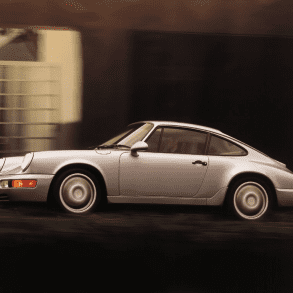
Porsche 911 Carrera 4 Coupe (964)
Years: 1989-1994
Engine: 3.6 L Flat 6 (M64/01)
Production: 13,353 units
Power: 250 bhp @ 6100 rpm
Torque: 229 ft/lbs @ 4800 rpm
0-60 mph: 5.6 seconds
Top Speed: 162 mph
The Type 964 911 first launch with an all wheel drive model. It was a serious investment by Porsche in updating the chassis and tech platform. The 964 Carrera 4 was powered by the M64/01 3.6 liter flat six engine, developing 250 bhp and 229 ft/lbs of torque.
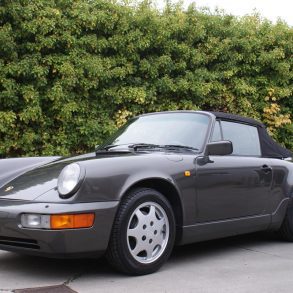
Porsche 911 Carrera 4 Cabriolet (964)
Years: 1990-1994
Engine: 3.6 L Flat 6 (M64/01)
Production: 4,802 units
Power: 250 bhp @ 6100 rpm
Torque: 229 ft/lbs @ 4800 rpm
0-60 mph: 5.7 seconds
Top Speed: 162 mph
The Carrera 4 model also launched with a Cabriolet version in 1989 (for 1990 model year). The added weight needed meant that both the Coupe and Cab needed ABS brakes and power steering (a first for a 911).
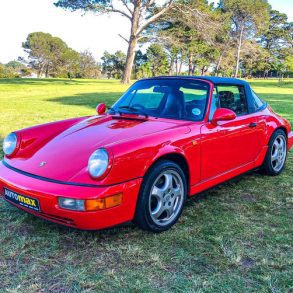
Porsche 911 Carrera 4 Targa (964)
Years: 1990-1993
Engine: 3.6 L Flat 6 (M64/01)
Production: 1,329 units
Power: 250 bhp @ 6100 rpm
Torque: 229 ft/lbs @ 4800 rpm
0-60 mph: 5.6 seconds
Top Speed: 162 mph
In addition to the Coupe and Cabriolet versions, the 964 Carrera 4 had a Targa bod. Last generation Targa with traditional removable Targa roof (till 991). Only 1,329 of the C4 Targas were sold.
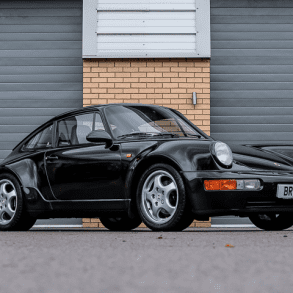
Porsche 911 ’30 Jahre’ Anniversary (964)
Years: 1993-1993
Engine: 3.6 L Flat 6 (M64/01)
Production: 911 units
Power: 250 bhp @ 6100 rpm
Torque: 229 ft/lbs @ 4800 rpm
0-60 mph: 5.7 seconds
Top Speed: 162 mph
1993 marked the 30th anniversary of the launch of the 911 and to celebrate Porsche produced a bespoke build spec, limited edition car – the 911 ’30 Jahre’ Anniversary edition 964. It had “Turbo” body coupled with AWD Carrera running gear.

Porsche 911 Carrera 4 Turbo-Look
Years: 1994-1994
Engine: 3.6 L Flat 6 (M64/01)
Production: 267 units
Power: 250 bhp @ 6100 rpm
Torque: 229 ft/lbs @ 4800 rpm
0-60 mph: 5.7 seconds
Top Speed: 162 mph
Model year 1994. Carrera 4 Widebody for the U.S market. Technically there is really no difference between the Carrera 4 Wide-Body and his RoW counterpart. At the front there are the for America usual black impact absorbersand the rear bumper is equipped with the center piece.
Porsche 964 Carrera 2
Model Years: 1990-1994 / Engine: 3.6 L Aircooled Flat 6 (M64/01 M64/02) / Production: 34,398 / Body Styles: Coupe, Cabriolet, Targa
964 Carrera 2 Coupe, Cab & Targa. While it was developed alongside the 964 Carrera 4, Porsche waited a year to release the Carrera 2 as a 1990 model year car. It launched with Coupe, Cabriolet and Targa body styles. The rear-engined, rear wheel drive C2 was 220 lb lighter than its C4 sibling was more fun to drive, was sportier and was considered a true successor to the Carrera 3.2 of 1984. The Coupe was (and still is) the enthusiast sports car driver’s choice, while the Targa and Cabriolet were (and still are) popular with those who want their 911 experience with some fresh air.
From the outside the Carrera 2 looks exactly like the Carrera 4 other than the obligatory ‘2’ on engine lid versus a ‘4’ for the Carrera 4. Starting in January 1990 the Carrera 2 body styles were available with a new Tiptronic (automatic) gearbox with manual override. This 4-speed Tiptronic unit got the M64/02 engine while the 5-speed manual got the M64/01 engine.
Turbo-Look Models. Several additional model variants of the C2 came over the following years. In 1992 there was the 964 C2 Cabriolet Turbo-Look (often called the C2 WTL Cabrio), which took the body, chassis, braking system and wheels from the 911 Turbo 3.3. In the USA, the C2 Cabriolet also got a Turbo body variant and was called the 911 America Roadster.
964 Carrera 2 Speedster. The 964 Speedster came along in 1994. It was based on the Carrera 2 platform and was available as both a standard or lightweight trim (known by many as the "clubsport" version). It had the same engine as the base Carrera and didn’t have the same suspension bits as the RS, but thanks to a removable windshield and an interior stripped of all niceties, it fit the role of driver's car rather neatly. Porsche planned to build 3,000 of these Speedsters however in two years of production only 936 ever made it out the factory doors. 936 standard 964 C2 Speedsters were built (well short of the 3,000 originally planned) but 15 cars were taken by the Zuffenhausen skunkworks and built using the widened Turbo body shell and were known as the 964 911 Speedster (Turbo-Look).
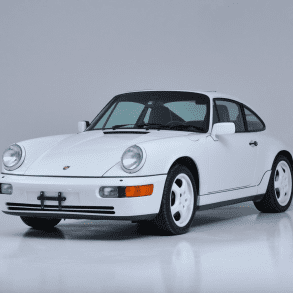
Porsche 911 Carrera 2 Coupe (964)
Years: 1990-1994
Engine: 3.6 L Flat 6 (M64/01, M64/02)
Production: 18,219 units
Power: 250 bhp @ 6100 rpm
Torque: 229 ft/lbs @ 4800 rpm
0-60 mph: 5.6 seconds
Top Speed: 162 mph
While it was developed alongside the 964 Carrera 4, Porsche waited a year to release the Carrera 2 as a 1990 model year car. The rear-engined, rear wheel drive C2 was 220 lb lighter than its C4 sibling was more fun to drive, was sportier and was considered a true successor to the Carrera 3.2 of 1984.

Porsche 911 Carrera 2 Cabriolet (964)
Years: 1990-1994
Engine: 3.6 L Flat 6 (M64/01, M64/02)
Production: 11,013 units
Power: 250 bhp @ 6100 rpm
Torque: 229 ft/lbs @ 4800 rpm
0-60 mph: 5.7 seconds
Top Speed: 162 mph
Just like the C2 coupe but with a fabric roof and open top fun. From the outside the Carrera 2 looks exactly like the Carrera 4 other than the obligatory ‘2’ on engine lid versus a ‘4’ for the Carrera 4. Starting in January 1990 the Carrera 2 body styles were available with a new Tiptronic (automatic) gearbox.
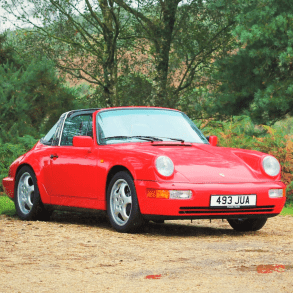
Porsche 911 Carrera 2 Targa (964)
Years: 1990-1993
Engine: 3.6 L Flat 6 (M64/01, M64/02)
Production: 3,534 units
Power: 250 bhp @ 6100 rpm
Torque: 229 ft/lbs @ 4800 rpm
0-60 mph: 5.7 seconds
Top Speed: 162 mph
Last generation Targa with traditional removable Targa roof (till 991). The Targa top was quite a project to take off (compared to the simple and fast cabriolet process). There are two levers in the glovebox that release the latch above the windscreen, then you need to play around inserting them before swinging them.
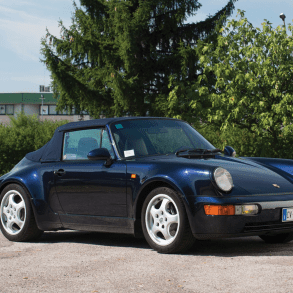
Porsche 911 Carrera 2 Cabriolet Turbo-Lk
Years: 1992-1993
Engine: 3.6 L Flat 6 (M64/01, M64/02)
Production: 1,532 units
Power: 250 bhp @ 6100 rpm
Torque: 229 ft/lbs @ 4800 rpm
0-60 mph: 5.6 seconds
Top Speed: 162 mph
Body, chassis and braking system and wheels from the 911 Turbo 3.3. Porsche 911 Type 964 Carrera 2 ‘Works Turbo Look’ Cabriolet was a special model in the 964 lineup. It gave buyers of the Carrera 2 Cab the great wide look of the Turbo cars and the Carrera 2 engine. The model was available as a 1992 and 1993 model years.
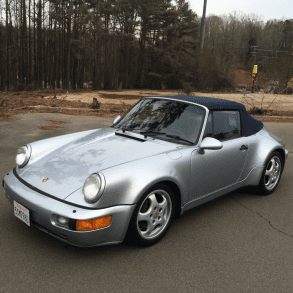
Porsche 911 America Roadster (964)
Years: 1992-1992
Engine: 3.6 L Flat 6 (M64/01)
Production: 326 units
Power: 250 bhp @ 6100 rpm
Torque: 229 ft/lbs @ 4800 rpm
0-60 mph: 5.6 seconds
Top Speed: 162 mph
The 1992 through 1993 Porsche 911 America Roadster is a limited production cabriolet variant of the 964 Carrera 2 with a Turbo body, intended for the North American market. It had the same mechanical setup as the Carrera 2, but its fender flares, brakes, suspension, and wheels were upgraded to Turbo-spec.
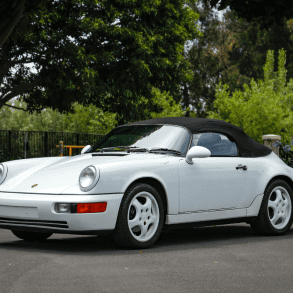
Porsche 964 911 Speedster (964)
Years: 1993-1994
Engine: 3.6 L Flat 6 (M64/01)
Production: 936 units
Power: 250 bhp @ 6100 rpm
Torque: 229 ft/lbs @ 4800 rpm
0-60 mph: 5.5 seconds
Top Speed: 161 mph
The 1989 Speedster was primarily an aesthetic package, the 964 version sought a happy medium between the regular Carrera 2 and the hardcore Carrera RS. It had the same engine as the base Carrera and didn’t have the same suspension bits as the RS, but thanks to a removable windshield and interior stripped of niceties.
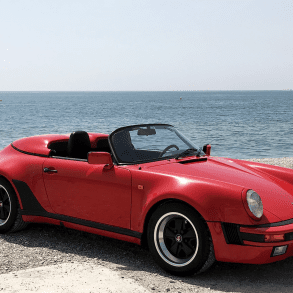
Porsche 911 Speedster (Turbo-Look) (964)
Years: 1993-1994
Engine: 3.6 L Flat 6 (M64/01)
Production: 15 units
Power: 250 bhp @ 6100 rpm
Torque: 229 ft/lbs @ 4800 rpm
0-60 mph: 5.5 seconds
Top Speed: 161 mph
15 Speedster got skunkworks love and got the widened Turbo body shell. In response to recurring customer requests for Turbo-Look Speedsters, Porsche reacted with the possibility of converting the previously individually ordered, narrow Speedster in the exclusive department. This is one rare customer special 911.
Porsche 964 Turbo
Model Years: 1991-1994 / Engine: 3.3 L Turbo Flat 6 (M30/69) & 3.6 L Turbo Flat 6 (M64/50) / Production: 5,097 / Body Styles: Coupe, Cabriolet (limited run)
964 911 Turbo 3.3. The 964 Turbo was the last of the single turbo rear-wheel drive 911 Turbos and was the successor to the famous 930 Turbo. Porsche engineers had been working on a new turbo motor for the 964 but were not fully ready in time for launch of the 964 Turbo. The result was that the 964 Turbo was initially released with the proven 3.3-litre turbo engine from the 930 Turbo. A number of updates improved the engine and power increased to 320 bhp at 5,750 rpm and torque was also up to 362 ft/lbs at 4,800 rpm. Stylewise, the 964 911 Turbo had a wider body with significantly more flared wheel housings compared to the 964 Carrera models. The rear wing was basically the same unit as the Turbo 3.3 of the G model. As expected the 964 Turbo a torque monster and was very rapid in a straight line. It was still characterized by lots of turbo lag (common in those days with all single turbo cars).
964 911 Turbo S 3.3. Several improvements to the 964 Turbo lead to the launch of the very special 964 Turbo S. The idea was to combine the 964 Turbo’s straight-line performance with the Carrera RS’s handling characteristics. The Porsche 964 Turbo S Leichtbau was born for model year 1993. Power was up to 380 horsepower (61 hp above the standard Turbo) thanks to thanks to more aggressive camshafts, new injection valves and more boost pressure. The Turbo also went on a serious diet and ended up almost 400 pounds lighter than the base Turbo model. Sound proofing was removed, power windows and power steering were removed, air conditioning and the rear seats were also ripped out. Fiberglass-reinforced carbon-composite panels were used for the doors, front trunk lid and the rear wing, while thin glass, Carrera RS bucket seats and RS door panels completed the lightweight construction. Only 86 examples were produced and it was a last hurrah for the 3.3 liter turbo engine as Porsche prepared to launch the new 3.6 liter Turbo a few months later.
964 911 Turbo Cabriolet. One of the rarest Porsche models ever was the 964 Turbo Cabriolet. Based on Carrera 2 Cabriolet Turbo-Look bodies, six Turbo Cabriolets were produced at the end of the series after the 1993 factory holidays. The engine and transmission of the 964 Turbo 3.3 were used (although some people have also said that the Turbo 3.6 units were also used on a few of them).
964 Turbo S2. A forgotten part of the 964s history is the Turbo S2. It was built to adhere to homologation rules so Porsche could participate in IMSA's sports car racing series. IMSA's homologation rules meant that Porsche had to build at least 200 road-going versions of the participating car, 20 of which needed to share most of the primary components of the race car. The 911 Turbo S2 was built specifically for this purpose and exclusively for the United States and Canada. The 20 homologation specials left the factory as stock 964 Turbos, heading immediately to California-based tuner for "S2" engine upgrades. Power ended up at 322 horsepower via a K27 turbocharger, larger intercooler, tweaked cam profile, and ported and polished cylinder heads.
964 911 Turbo 3.6. The second generation of 964 Turbo 3.6 launched as a 1993 model year car. The 3.3 liter turbo engine was replaced by a 3.6 liter turbo engine based on the M64 power unit in the 964 Carrera 2 and Carrera 4. Power was up to 360 bhp @ 5,500 rpm and torque was up to 384 ft/lbs @ 4,200 rpm. Other mechanical upgrades included better brakes, lower suspension and 18 inch 3-piece Speedline wheels. The 964 Turbo 3.6 also got large red brake callipers. Less than 1,500 examples were produced as Porsche prepared for the launch of the Type 993 911 in 1994.
964 Turbo 3.6 S. At the end of 964 production in 1994, the Porsche factory had 93 Turbo chassis left. These were all transferred to Porsche Exclusiv and hand built as the very special 964 Turbo 3.6 S. They were offered with normal, or ‘Flachbau’ slant nose front ends. While the vast majority of Turbo S’ were fitted with the ‘Flachbau’ nose as a no-cost option, the Turbo S could also be had with the traditional 964 nose as well. In all, 76 Flatnose cars were made while 17 non-Flatnose (known as Package option) cars were made. These cars were also fitted with the X88 option, which increased power to 380 horsepower as well as added an auxiliary oil cooler.
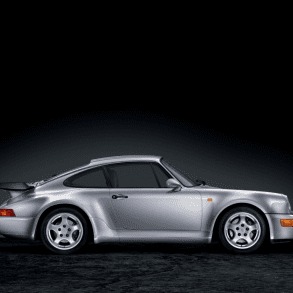
Porsche 911 Turbo 3.3 (964)
Years: 1991-1992
Engine: 3.3 L Turbo Flat 6 (M30/69)
Production: 3,660 units
Power: 320 bhp @ 5,750 rpm
Torque: 332 ft/lbs @ 4,500 rpm
0-60 mph: 5.4 seconds
Top Speed: 168 mph
From model year 1991 onwards Porsche also introduced its top-of-the-line model - the Turbo - into this series. In spite of bearing a major similarity in terms of look to the naturally-aspirated model, the extended wings remained. The 964 Turbo model was the successor to the Porsche 930. The last of the single turbo RWD 911 Turbos.
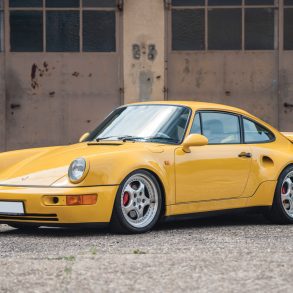
Porsche 911 Turbo S 3.3 ‘Leichtbau’
Years: 1992-1993
Engine: 3.3 L Turbo Flat 6 (M30/69)
Production: 86 units
Power: 381 bhp @ 6,000 rpm
Torque: 362 ft/lbs @ 4,800 rpm
0-60 mph: 4.6 seconds
Top Speed: 180 mph
Built to celebrate the IMSA Supercar Championship of the Brumos Porsche team. Porsche built 86 examples, including the car offered here. Visually similar to the 964 Carrera RS 3.8, the new Turbo S Lightweight in fully stripped trim weighed a svelte 2,850 lbs., over 400 lbs. less than a standard Turbo S.
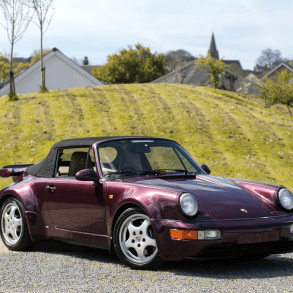
Porsche 911 Turbo Cabriolet (964)
Years: 1993
Engine: 3.6 L Turbo Flat 6 (M64/50)
Production: 6 units
Power: 380 bhp @ 5,750 rpm
Torque: 384 ft/lbs @ 5,000 rpm
0-60 mph: 4.0 seconds
Top Speed: 174 mph
The Register says six Turbo-look cabriolets were pulled off the production line in Zuffenhausen and transported to the Porsche Exclusive shop in Weissach. Three of these were equipped with left-hand drive for buyers in Germany (Code C00), and three more were fitted with right-hand drive.
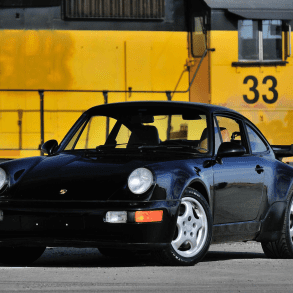
Porsche 911 Turbo S2 (964)
Years: 1992-1992
Engine: 3.6 L Turbo Flat 6 (M64/50)
Production: 20 units
Power: 322 bhp @ 5,750 rpm
Torque: 332 ft/lbs @ 4,500 rpm
0-60 mph: – seconds
Top Speed: – mph
A forgotten part of the 964s history is the Turbo S2. It was built to adhere to homologation rules so Porsche could participate in IMSA's sports car racing series. The 20 homologation specials left the factory as stock 964 Turbos, heading immediately to California-based tuner for "S2" engine upgrades.

Porsche 911 Turbo 3.6 (964)
Years: 1993-1994
Engine: 3.6 L Turbo Flat 6 (M64/50)
Production: 1,437 units
Power: 360 bhp @ 5,500 rpm
Torque: 384 ft/lbs @ 4,200 rpm
0-60 mph: 4.7 seconds
Top Speed: 174 mph
Engine based on modified 3.6 litre 964 unit. Speedline wheels with big red brake calipers. Lessons learned in the Carrera Cup series proved the reliability of the new 3.6-litre engine. An additional three millimetres on the bore and two millimetres on the stroke, resulted in an increase in capacity of 300 cc.
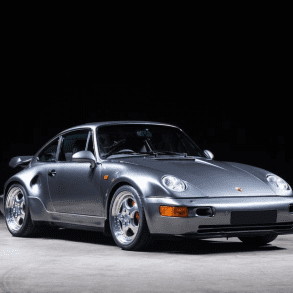
Porsche 911 Turbo 3.6 S ‘Flatnose’ (964)
Years: 1994-1994
Engine: 3.6 L Turbo Flat 6 (M64/50)
Production: 75 units
Power: 380 bhp @ 5,750 rpm
Torque: 384 ft/lbs @ 5,000 rpm
0-60 mph: 4.0 seconds
Top Speed: 174 mph
The Porsche factory had 93 Turbo chassis left. These were all transferred to Porsche Exclusiv and hand built as the very special 964 Turbo 3.6 S. They were offered with normal, or ‘Flachbau’ slant nose front ends. While the vast majority of Turbo S’ were fitted with the ‘Flachbau’ nose as a no-cost option, the Turbo S could also be had with the traditional 964 nose as well.
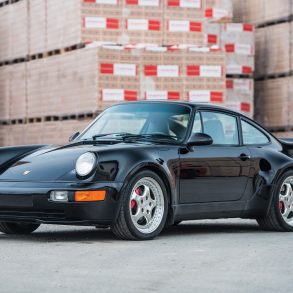
Porsche 911 Turbo 3.6 S ‘Package’ (964)
Years: 1994
Engine: 3.6 L Turbo Flat 6 (M64/50)
Production: 19 units
Power: 380 bhp @ 5,750 rpm
Torque: 384 ft/lbs @ 5,000 rpm
0-60 mph: 4.0 seconds
Top Speed: 174 mph
19 non 'slant nose' or Package cars were made for the USA only. Very rare. The Porsche factory had 93 Turbo chassis left. These were all transferred to Porsche Exclusiv and hand built as the very special 964 Turbo 3.6 S. They were offered with normal, or ‘Flachbau’ slant nose front ends. The Turbo S could also be had with the traditional 964 nose as well.
Porsche 964 RS
964 Carrera RS. In hommage to the 1973 911 Carrera RS, Porsche used the same formula to produce a lightweight version of the Carrera 2 from the race-ready Cup car known simply as the Carrera RS. The Porsche Carrera RS, or 964 RS as it is more widely known started shipping in November 1991 as a 1992 model year car.
A primary objective for Porsche engineers was making the 964 RS as light as possible and in the end they were able to take out almost 300 pounds of weight. The bonnet was made out of aluminium, the side and rear windows were made from a lighter, thinner-gauge glass. Sound-insulating interior mats were removed, the front fog lamps were replaced with transparent covers and even the rust preventative undercoat was omitted. Porsche also removed the power steering, power windows, rear seats, electronically adjustable front seats and front armrests. The 964 RS was also fitted with lightweight magnesium Cup wheels. At 2706 pounds the 964 RS was 286 pounds lighter than the standard model.
The RS used an upgraded version (M64/03) of the M64 engine used in the 964 Carrera 2 and 4 (M64/01). Power was boosted by 10 horsepower from the new 3.6 liter boxer engine thanks to some magic by Porsche engineers. The pistons and cylinders were carefully selected and matched and the engine used rubber mounts in place of hydraulic mounts. It also had a lightweight single-mass flywheel that weighed 12 pounds. A lighter and simpler wiring harness was fitted and the ECU was reconfigured for higher octane fuel. Power went from 250 hp to 260 hp and torque increased from 229 ft/lbs to 240 ft/lbs.
The chassis was stiffened thanks to additional bracing and welding in key areas. The suspension on the Porsche Carrera RS was lowered by 40mm and made considerably stiffer with race-tuned shock absorbers. The front brakes comprised cross-drilled discs with four-piston fixed callipers as used on the 911 Turbo. The rear brakes were taken from the Carrera Cup race car. Performance wise, the 964 RS had the same power and top speed as the coupe on which it was based. It out-accelerated its donor car by a lot thanks to its lighter weight. 0 - 60 mph was over in just 5.1 seconds (0.5 second faster than the standard C2). On the track it was awesome and easily bested the C2. If you want to understand cars like the recent 911 R, a car like the 964 RS is a good place to start. The 964 Carrera RS was offered in three road legal versions. The first was a base option that offered no luxury at all, the second, a touring model, came with limited extras and the third was the N-GT (near-production GT).
964 RS America. The original 1973 Carrera RS was available in Europe but not in the USA. Porsche decided to build the 1993 Carrera RS both to European spec and a limited number in compliance with US regulations. These US spec cars were assigned the name “RS America”. The intent was to create a basic lightweight, no frills 911 with minimal luxury options.
The standard US Carrera 2 brakes, engine and gearbox were used. The RS weighed 2,945 pounds so it was almost 80 pounds lighter than a standard Carrera 2. Fitting the RS America with the M030 sport suspension package, which included the use of much of the running gear from the 911 C2 Turbo, led to higher performance limits. The Turbo's progressively wound coil springs, larger diameter front stabilizer bar, and upgraded shock absorbers were standard equipment for the RS America, as were 17” diameter C2 Turbo wheels. The RSA rims were 7” wide on the front and 8” wide on the rear (as opposed to the 7” wide front and 9” wide rear wheels of the C2 Turbo). It also got a very cool "whale tail" spoiler. In all, 701 cars were built as model year 1993 - 1994.
964 Carrera RS 3.8. Porsche wanted to race an RSR variant in the GT-category and the result was the car you see here, the Porsche 911 Carrera RS 3.8 (964). The RS 3.8 served as the homologation base for the 3.8 RSR for international competition. Basically the road going version of the Porsche 911 Carrera RSR 3.8 race cars it is still one of the most special Porsche cars ever made. Many of its features were borrowed from the 964 Carrera Cup cars. There were two versions; the Sport (or Lightweight) weighed about 10 percent less than the Touring version. Only 55 cars were ever made and they were all special ordered from the factory.
The RS 3.8 body is based on the 911 Turbo with the flared wheel arches. The RS 3.8 also had a more advanced aerodynamic profile thank the Turbo thanks to a deeper front spoiler and a large fixed bi-plane rear wing that was adjusted (and had a cool embossed "3.8" logo on its sides). It also got stronger chassis thanks to additional welding and strengthening throughout the shell. The RS 3.8 also got larger brakes and wheels.
Power for the RS 3.8 came from a 3.8 liter version of the M64 motor and was good for 300 bhp. The engine was bored out by 2 mm for a total of 3,746 cc and had a raft of other upgrades. The compression ratio was upped, it had a new intake system with individual throttle butterflies, bigger inlet and exhaust valves and even had its engine-management system software revised. It was known as the M64/04 type engine. An absolute legend.
964 C4 Lightweight. The rarest 964 RS variant was the awesome 964 C4 Lightweight. Known as the 964 Leichtbau it made use of surplus parts from 953 Paris-Dakar project and only 22 were ever made. The idea was to combine the 964 RS body with the more sophisticated all-wheel-drive system from the 959 while lowering weight.
The 964 C4 Lightweight was powered by the same 3.6 liter flat six as the normal 964 RS, but was fettled to produce 300 hp (the 964 RS made do with 260 hp). Porsche engineers freed the extra horsepower by removing the catalytic converters and mufflers. A special clutch and flywheels were mated to the car’s five-speed manual transmission. The coolest feature of the powertrain was the use of a Rally-style gearbox (thanks 953 Paris-Dakar project) that allowed the driver to adjust the torque split of the centre and rear differentials via two rotary controls on the centre console.
The RS Lightweight earned its name thanks it's scant 1098 kg weight. The car was based on the M003-optioned RS shell albeit now with four-wheel drive. The combined use of an aluminum front lid, aluminum doors, Plexiglas side windows and a fiberglass rear engine lid as well as the removal of many niceties definitely contributed. Porsche did more than simply replace body panels with aluminum and fiberglass and delete sound insulation and carpeting however. The car was race-ready with a seam-welded tub and fixed windows with sliding panels. One visual clue to the identity was in the re-adoption of the external oil filler, just in front of the right rear wing.
From a performance perspective the 964 C4 Lightweight was unique. Thanks to its 2,400 pound weight and very short gearing it was only able to hit a 125 mph top speed, but acceleration was absurdly fast. Official Porsche numbers quite 0 - 60 mph in 4.5 seconds but most testing showed the car was actually able to do 0 - 60 mph in only 3.9 second times.
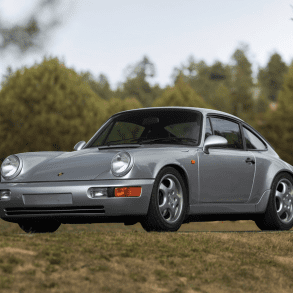
Porsche 911 Carrera RS (964)
Years: 1991-1992
Engine: 3.6 L Aircooled Flat 6 (M64/03)
Production: 2,282 units
Power: 260 bhp @ 6100 rpm
Torque: 229 ft/lbs @ 4800 rpm
0-60 mph: 5.1 seconds
Top Speed: 162 mph
The 964 Carrera RS (Standard) was introduced by Porsche for model year 1992 specifically for the European market as a lightweight, high performance version of the 964 Carrera 2. It featured a revised version of the standard 3.6 liter engine, titled M64/03 internally, with an increased power output of 260 bhp (194 kW; 264 PS).
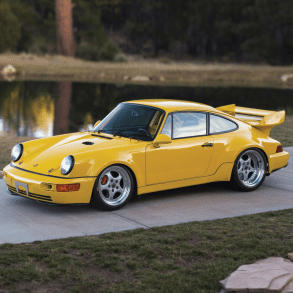
Porsche 911 Carrera RS 3.8 (964)
Years: 1993
Engine: 3.8 L Aircooled Flat 6 (M64/04)
Production: 55 units
Power: 300 bhp @ 6,100 rpm
Torque: 265 ft/lbs @ 4,800 rpm
0-60 mph: 4.9 seconds
Top Speed: 169 mph
The 964 Carrera RS 3.8 was produced as a base for homologation for the venerable 3.8 RSR. It featured the wide-body look of the Type 964 Turbo, a massive rear spoiler, and three-piece “Speedline for Porsche” wheels with 235/40 and 285/35 tires, making it more aggressive in look than the restrained styling of the Carrera RS.
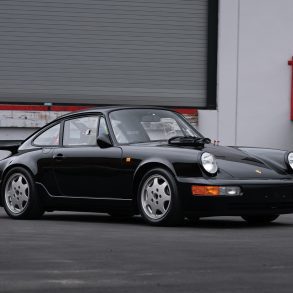
Porsche 911 Carrera 4 Lightweight (964)
Years: 1993-1993
Engine: 3.6 L Flat 6 (M64/01)
Production: 22 units
Power: 300 bhp @ 6500 rpm
Torque: 265 ft/lbs @ 5250 rpm
0-60 mph: 3.9 seconds
Top Speed: 125 mph
The rarest 964 RS variant was the awesome 964 C4 Lightweight. Known as the 964 Leichtbau it made use of surplus parts from 953 Paris-Dakar project. A handful of specially prepared lightweight 911s were fabricated by the Porsche factory and called the Carrera 4 RS Lightweight. RS Body with 959-like AWD and more power.
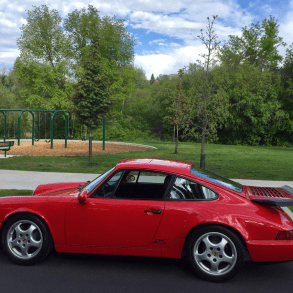
Porsche 911 Carrera RS America (964)
Years: 1993-1994
Engine: 3.6 L Flat 6 (M64/01, M64/02)
Production: 701 units
Power: 250 bhp @ 6100 rpm
Torque: 229 ft/lbs @ 4800 rpm
0-60 mph: 5.3 seconds
Top Speed: 164 mph
Porsche decided to build the 1993 Carrera RS both to European spec and a limited number in compliance with US regulations. These US spec cars were assigned the name “RS America”. The intent was to create a basic lightweight, no frills 911 with minimal luxury options. Standard US Carrera 2 brakes, engine and gearbox used.
Porsche 964 Race Cars
964 Carrera Cup. In 1990 Porsche devised a racing series for the 964 Carrera 2 known as the 1990 Pirelli Carrera Cup Competition and later series such as the Trophie Series and the 1993 Supercup. These cars were completely stripped out for series racing by fitted with aluminum shut panels and a roll-bar system. They were fitted with the M64/03 with a bespoke aluminum intake and a G50/10 gearbox, but almost every system in the car was updated for race preparation.
Many of these developments were pushed onto the limited Carrera RS in 1992. In 1990 and 1991 Porsche made a total of 172 Carrera Cup cars. These were updated to M0001 specification in 1992 with a two-year production of 127 cars bringing the four year total to 299 Carrera Cup cars.
964 Carrera 3.8 RSR. The 964 Carrera RSR reflected Porsche’s return to production-based GT racing dominance. The Carrera RSR 3.8 was an all-out racing car and could be delivered to the track in a race-ready, ‘just-add-driver’ form. The engine of this car was further tweaked and fitted with racing cams, the output varying from 325bhp to 375bhp, depending on track requirements.
Based on the only slightly less-potent RS 3.8, the RSR was a full-bore lightweight Turbo-bodied beast aimed at major European GT contests and the North American Supercar series. The rear of the 911 Turbo’s wide body was occupied by a model-specific Type M64/04 3.8-liter air-cooled flat-six, naturally aspirated with 11.4:1 compression, lighter pistons, dual ignition, new intake manifolds with six individual butterflies, dry-sump lubrication, and Bosch electronic fuel injection. Power was fed through a racing clutch to an uprated five-speed manual transaxle with 40 percent limited-slip.
964 Carrera RS Competition. For race teams and track day customers Porsche prepared a small number of the 964 Cup cars according to the FIA NG-T regulations. Officially called the Competition model, these custom-ordered cars were an intermediary step between the Carrera Cup option (M001) and the standard tourer (M002). This M0003 option was available directly from Porsche as a road-going model.
These cars had almost all the Carrera Cup modifications including the new suspension. This lowered the car by 40mm in the rear and 50mm in the front. It also included fitting of the larger 930 Turbo disc brakes and adjustable anti-roll bars. The same weight reducing measures included thinner windows, stripped interior, aluminum panels and Recaro racing seats which helped lower the bulk by 200kg. Mechanical preparation included a specially-built engine with a new intake manifold, lighter fly-wheel and larger air filter. In the suspension all the rubber elements were replaced with rigid ball-joints. Similarly, uprated Bilstein shock-absorbers were fitted.
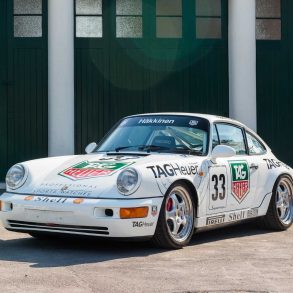
Porsche 911 Carrera Cup (964)
Years: 1990-1992
Engine: 3.6 L Aircooled Flat 6 (M64/03)
Production: 299
Power: 260 bhp @ 6,100 rpm
Torque: 240 ft lbs @ 4,800 rpm
0-60 mph: – seconds
Top Speed: – mph
In 1990 Porsche devised a racing series for the 964 Carrera 2 known as the 1990 Pirelli Carrera Cup Competition.
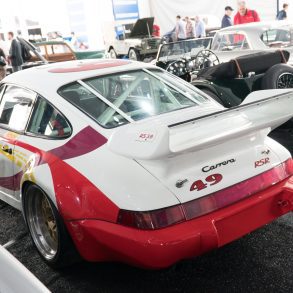
Porsche 911 Carrera 3.8 RSR (964)
Years: 1993-1994
Engine: 3.8 L Aircooled Flat 6 (M64/04)
Production: 45
Power: 300 bhp @ 6500 rpm
Torque: 265 ft/lbs @ 4,800 rpm
0-60 mph: 3.7 seconds
Top Speed: 181 mph
The Carrera RSR 3.8 was an all-out racing car. The RSR 3.8 could be delivered to the track in a race-ready, ‘just-add-driver’.
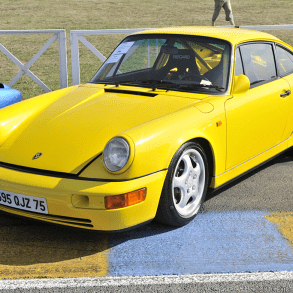
Porsche 911 Carrera RS Competition
Years: 1992-1992
Engine: 3.6 L Aircooled Flat 6 (M64/03)
Production: –
Power: 260 bhp @ 6,100 rpm
Torque: 229 ft/lbs @ 4,800 rpm
0-60 mph: – seconds
Top Speed: – mph
For race teams and track day customers Porsche prepared a small number of the 964 Cup cars according to FIA regs.
Porsche 911 (964) Engine Guide
Non Turbo 964 Engines
M64/01, M64/02, M64/03, M64/04
There are three basic engines used in the non-Turbo 964’s. They are the M64/01, M64/02 and M64/03. The 964 engines were the first produced by Porsche which were the same for all markets, worldwide. All three engines were naturally aspirated, air-cooled or oil-cooled, horizontally opposed (flat), dry-sump lubrication and obviously rear-mounted and all three had a displacement of 3600cc.
The M64 engine is oil and air cooled and, as a consequence, has a lot of oil (11.5 liters) when compared to a more usual water cooled engine. Air is blown over the engine from the main crankshaft driven fan and is also drawn over the engine as the vehicle moves forward. Oil is routed throughpipes along the right hand sill to the front mounted oil cooler which is called into play once the oil thermostat (in front of the right rear wheel) opens. The engine uses a dry sump lubrication system which avoids oil starvation issues in extreme G-force conditions. Using 2 valves per cylinder with a single chain driven overhead camshaft per cylinder bank operating both inlet and exhaust valves via rocker arms, the engine design is heavily based on that of the GT1 racer.
The M64/01 was fitted to the standard Carrera 2 and Carrera 4 models with manual transmissions. The M64/02 was fitted to the Tiptronic-equipped Carrera 2. The M64/01 and M64/02 had 100 mm Bore and 76.4mm Stroke, with a compression ratio of 11.0:1. The M64/03 was fitted to the Carrera RS. It had a remapped engine program and slightly higher compression ratio of 11.3:1 when compared to the M64/01 and M64/02. The result was a bit more horsepower at 260 hp at 6,100 rpm and torque of 229 ft/lbs at 4,800 rpm.
There was also a super rare M64/04 engine used in the Carrera RS 3.8. The engine was known as M64/04. While retaining the same 76.4 mm stroke of the 3.6 liter, the bore was stretched to 102mm, increasing the engine capacity to 3746cc. It also had larger valves, individual throttles and a 11.6:1 compression ratio. In the RS 3.8, the engine produced 300 bhp @ 6100 rpm and torque of 265 ft/lbs @ 4800 rpm. It was further tweaked for the RSR with racing cams and the output varied from 325bhp to 375bhp, depending on the restrictors fitted according to the different class regulations applicable.
Turbo 964 Engines
M30/69, M64/50
When the 964 Turbo was unveiled in 1990, Porsche reused the 3.3 liter engine from the Type 930 because it did not have the necessary time to develop a turbo version of the 3.6 liter M64 engine before it released the Turbo variant.
A few revisions were made to increase power, but it was basically the same basic engine. Displacement was 3,299 cc (201.3 cu in) and the compression ration was 7.0:1.
Power was 320 bhp at 5,750 rpm and torque was 362 ft/lbs at 4,800 rpm. The turbo had less turbo lag than the 930 engine and was different enough that it was designated with its own M30/69 code.
A more powerful version of the turbo engine was used in the very limited edition 964 Turbo S 3.3. Power was up from 320 hp to 381 bhp at 6000 rpm with torque of 362 ft/lbs at 4800 rpm.
The 3.6L M64 turbo was finally made available in 1993 and was known as the M64/50 engine. It was a marked improvement over the old M30/69 engine and powered all Turbo 964 models after 1993. The engine had a 3,600 cc (220 cu in) displacement with a 7.5:1 compression ratio. This fine-tuned version of the M64 engine produced an impressive 360 bhp at 5,500 rpm and 384 ft/lbs at 4,200 rpm.
A more powerful version of the M30/69 engine was used in the 964 Turbo S 3.6. Power was up 20 hp to 380 hp at 5,750 rpm and torque was the same 384 ft/lbs.


